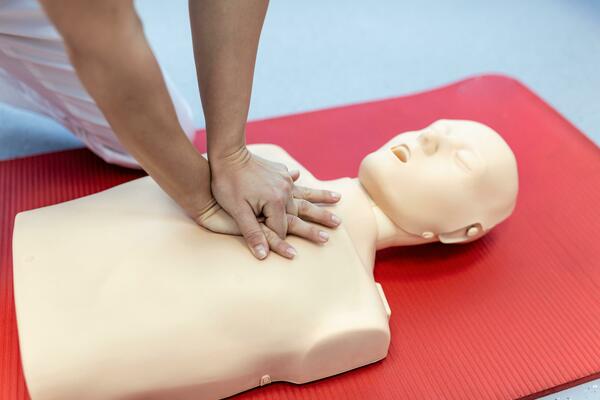
Understanding AHA BLS Certification: The Foundation of Emergency Care
AHA BLS certification (American Heart Association Basic Life Support) is a professional-level credential that trains healthcare providers and emergency responders in essential life-saving techniques. This comprehensive certification program teaches participants how to recognize cardiovascular emergencies, perform high-quality CPR, use automated external defibrillators (AEDs), and provide emergency care for choking victims across all age groups.
What Does AHA BLS Stand For?
BLS: Basic Life Support – fundamental emergency medical interventions that can save lives before advanced medical help arrives
AHA: American Heart Association – the leading authority in cardiovascular care and resuscitation science
Core Components of AHA BLS Certification
High-Quality CPR Training
AHA BLS certification focuses extensively on high-quality cardiopulmonary resuscitation techniques, including:
- Proper compression depth: 2 inches for adults and children, 1.5 inches for infants
- Compression rate: 100-120 compressions per minute
- Complete chest recoil: Allowing full chest expansion between compressions
- Minimal interruptions: Keeping pauses to less than 10 seconds
- Effective ventilations: Proper airway management and rescue breathing
AED Operation and Safety
Participants learn comprehensive automated external defibrillator skills:
- AED setup and operation procedures
- Pad placement for adults, children, and infants
- Safety protocols during defibrillation
- Integration of AED use with CPR cycles
Choking Response Techniques
The certification covers foreign body airway obstruction management:
- Abdominal thrusts for conscious adults and children
- Back slaps and chest thrusts for infants
- Procedures for unconscious choking victims
Team Dynamics and Communication
Multi-rescuer scenarios emphasize:
- Effective team communication during emergencies
- Role assignment and coordination
- Leadership during resuscitation efforts
- Seamless transitions between team members
Who Needs AHA BLS Certification?
Healthcare Professionals
AHA BLS certification is typically required for:
- Registered nurses and licensed practical nurses
- Medical doctors and physician assistants
- Emergency medical technicians (EMTs) and paramedics
- Medical assistants and certified nursing assistants
- Respiratory therapists and physical therapists
- Dental professionals and dental hygienists
Emergency Response Personnel
- Firefighters and rescue personnel
- Police officers and security professionals
- Lifeguards and swimming instructors
- School nurses and athletic trainers
Medical Students and Healthcare Trainees
Most healthcare education programs require AHA BLS certification before:
- Clinical rotations and practicum experiences
- Internships and residency programs
- Professional licensing examinations
AHA BLS vs Other Certifications: What Makes It Different?
American Heart Association Authority
The AHA is recognized as the gold standard in resuscitation training because:
- Evidence-based guidelines updated every 5 years
- Extensive research backing all protocols
- Global recognition by healthcare institutions
- Rigorous instructor certification requirements
Healthcare-Specific Focus
Unlike basic CPR courses, AHA BLS certification includes:
- Advanced airway management techniques
- Professional-level assessment skills
- Hospital and clinical environment scenarios
- Integration with advanced life support protocols
Employer Preference
Most healthcare employers specifically require AHA BLS certification because:
- Meets Joint Commission accreditation standards
- Satisfies state licensing board requirements
- Ensures consistency across healthcare teams
- Provides liability protection for institutions
Course Formats Available
Traditional Classroom Training
Instructor-led BLS classes provide:
- Face-to-face instruction with certified AHA instructors
- Hands-on practice with mannequins and AED trainers
- Real-time feedback and skill correction
- Interactive group scenarios and discussions
HeartCode BLS (Blended Learning)
HeartCode BLS combines online and in-person components:
- Self-paced online cognitive learning
- In-person skills demonstration and testing
- Flexible scheduling for busy professionals
- Same certification outcome as traditional classes
Certification Requirements and Validity
Testing and Assessment
To earn AHA BLS certification, candidates must:
- Pass a written examination with 84% or higher score
- Demonstrate hands-on skills competency
- Successfully complete scenario-based assessments
- Show proficiency in all age groups (adult, child, infant)
Certification Duration
AHA BLS certificates are valid for exactly 2 years from the issue date, after which renewal is required to maintain active status.
Continuing Education Credits
Many AHA BLS courses provide CME/CEU credits for:
- Nursing license renewal requirements
- Medical professional development
- Hospital credentialing maintenance
- Career advancement documentation
Local AHA BLS Training Opportunities
CPRzone.org offers convenient AHA BLS certification classes throughout Pennsylvania with weekly sessions in:
- Harrisburg BLS classes: Central Pennsylvania’s premier training location
- Exton BLS certification: Serving Chester County and surrounding areas
- Ephrata BLS training: Lancaster County’s trusted certification provider
- Bethlehem BLS courses: Lehigh Valley’s preferred training center
Our certified AHA instructors ensure every participant receives personalized attention and comprehensive skills training in a supportive learning environment.
Benefits of AHA BLS Certification
Professional Advancement
AHA BLS certification enhances career prospects by:
- Meeting mandatory employment requirements
- Demonstrating commitment to patient safety
- Qualifying for specialized healthcare positions
- Supporting professional license maintenance
Personal Confidence
Certified individuals gain:
- Confidence to respond during medical emergencies
- Knowledge to potentially save family members’ lives
- Skills transferable to community volunteer opportunities
- Peace of mind in emergency situations
Legal Protection
Good Samaritan laws provide legal protection for certified individuals who:
- Provide emergency care within their training scope
- Act reasonably and without expectation of payment
- Follow established protocols and procedures